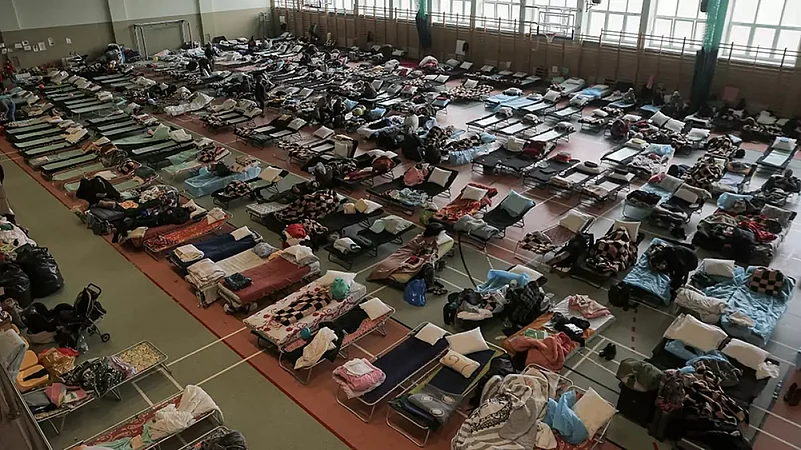Persecution, violence, conflict, human rights violations, and poverty forcefully displaced 108.4 million people – including 35 million refugees – all over the world, by the end of 2022. Nearly 600 refugees and migrants were added to this tally this year after the horrific migrant boat disaster off the coast of Greece.
The United Nations High Commission for Refugees (UNHCR) defines a refugee as a person outside their own country of citizenship or permanent residence who, because of their race, religion, nationality, political opinion or membership in social groups, fear persecution, cannot avail themselves of the protection of their own country or cannot return there for fear of persecution. The organisation estimates that one in every 74 people on Earth has been forced to flee.
Where do these refugees come from – and where do they go?
Six months into 2023, almost 52 per cent of refugees who are under the mandate of UNHCR, came from just three countries – Syria, Ukraine, and Afghanistan.
Syria
The aftermath of the Arab Spring uprising in Syria in 2011 – which witnessed a series of protests against authoritarian regimes in the Middle East – that quickly blew over into a civil war, continues to affect its people today. More than a decade of war has unleashed poverty-stricken conditions upon millions of people. According to a report by AlJazeera, more than half the pre-war population of 23 million remains displaced, including more than five million who are refugees, mostly in neighbouring countries.
Ukraine
The second largest group of refugees of 5.7 million people are from Ukraine. As of February 2023, which marked one year since the Russian invasion of Ukraine, more than 13 million people remain uprooted from their homes, including nearly 8 million refugees across Europe and more than 5 million internally displaced people within Ukraine, according to the UNHCR.
Afghanistan
After the Taliban gained control over Afghanistan in 2021, a similar amount of people scrambled to flee from the country. More than 40 years of conflict, natural disasters, chronic poverty, food insecurity, COVID-19 pandemic leading up to the change in government have driven more than six million Afghans out of their homes or their country.
Hosts of refugees
Turkey, Iran, Colombia, Germany, Pakistan and Uganda, are the six countries that have hosted more than a third of all the refugees under UNHCR’s mandate. According to a report by DW, although the 46 least-developed countries in the world accounted for less than 1.3% of the world's gross domestic product in 2022, they also took in more than a fifth of all refugees.
This means that while the popular perception could be that most refugees from Asia and Africa flee to Europe, these are the areas that have witnessed the most amount of internal migration.
The United Nations says that the majority of migration is intra-regional or intra-African, especially in western and southern Africa, and only about 25 per cent of African migrants go to Europe.
Countries sealing their borders – A growing refugee crisis
However, many refugees are now running out of options. Countries are building razor wire barriers, four-kilometre-long fences and deploying armed forces to severely restrict the major routes used by hundreds of thousands of refugees. While in 2022, countries processed asylum requests faster than in previous years, the UNHCR said that backlogs keep growing due to “the sheer volume of new applications”.
The US received the most number of new applications for seeking asylum in 2022 with 7,30,400 claims. However, it is also the nation with the largest backlog in its asylum system, UNHCR chief Filippo Grandi told a press conference in Geneva. “One of the things that needs to be done is reforming that asylum system so that it becomes more rapid, more efficient,” he said.
Some countries, on the other hand, are sealing their borders to “stop irregular immigration,” with Europe at the forefront.
A European Parliament paper from 2022 stated that the European Union and the Schengen zone are now encircled by 19 border or separation fences, with a combined length of 2,048 kilometres (1,273 miles) — compared to just 315 kilometres in 2014. Meanwhile, the United States, Spain and Canada have announced plans to create asylum processing centres in Latin America with the goal of reducing the number of people who make their way north to the Mexico-U.S. border.
Apart from being shunned away from the border, refugees who embark on these journeys to flee from conflict and violence-ridden countries, are also exposed to a high risk of abuse, with some journeys becoming fatal.
According to data from United Nations' International Organization for Migration (IOM), at least 1,999 migrants died between January 1 and June 26 of this year, mostly from drowning in the three major routes across the Mediterranean, as well as at the Atlantic route from West Africa. In 2021, around 3,231 refugees were recorded as dead or missing at sea in the Mediterranean, with 1,881 in 2020, 1,510 in 2019, and more than 2,277 in 2018.
Even greater numbers may have died or gone missing along land routes through the Sahara Desert and remote border areas, according to an estimate by the UNHCR.
Since a peak in the number of crossings in 2015, in which more than a million refugees and migrants crossed the Mediterranean to Europe, the numbers of those making these journeys have seen a downward trend, even prior to the Covid-19 pandemic. In 2021, 123,300 individual crossings were reported, and prior to that 95,800 in 2020, 123,700 in 2019 and 141,500 in 2018. Despite the lower numbers of crossings, the deaths continue to rise.
In the latest of such horrific incidents, as many as 750, officials have estimated, with barely 100 survivors — migrants primarily from South Asia and the Middle East, were aboard a fishing boat to reach Europe. The boat capsized and sank off the southern coast of Greece – becoming one of the worst such disasters this year.
The Dreaded Mediterranean Route
This is not the first such incident.
Migrants and asylum seekers have been crossing the Mediterranean for decades. Since 2014, over 26,000 people have died or gone missing crossing the Mediterranean Sea, according to UN data. Most of these deaths or disappearances occurred in the Central Mediterranean, considered among the deadliest migration routes in the world.
The EU’s response to boat migration across the Mediterranean has focused largely on trying to prevent or discourage people attempting to make the dangerous crossing. This approach is also reflected in the EU’s current focus on anti-smuggling measures, including pre-emptive seizure and destruction of boats used by smugglers, as per a report by Human Rights Watch.
Greece Boat Accident
According to reports, about 750 men, women and children were on the packed boat when it capsized on June 14, killing hundreds. Many are still feared to be missing. Most of those on board were Pakistanis. They are among the thousands of people fleeing an economic crisis in the country that has left many people without hope.
Data from Frontex, the European Union's border and coast guard agency shows that a record number of nearly 5,000 Pakistanis were detected on the "central Mediterranean route" into Europe in the first five months of 2023.
The victims "could be alive today if there were better employment opportunities, economic security and political stability in Pakistan," Imran Khan, country director for Pakistan at the United States Institute of Peace, a US federal agency told DW.
While Greek authorities were criticised for not handling the crisis properly, the tragic incident also comes at a time when European countries and Britain are tightening their borders to curb illegal immigration. UK Prime Minister Rishi Sunak-led British Government and minister Suella Braverman have instructed border security to increase surveillance for ‘illegal immigrants coming on boats through the English Channel’.
The world is currently staring at a big humanitarian crisis. People who flee their countries to save themselves from getting persecuted, or to not succumb to poverty, are being trafficked under the garb of what they feel will be a better life. Meanwhile, desperate families hold on to hope that they might still get word that their loved ones were among the lucky ones rescued.


























